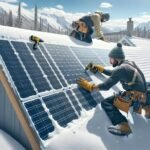Installing solar panels at your Canadian home can be a game-changer for both your wallet and the environment. But, diving into DIY solar wiring without proper knowledge can lead to costly and dangerous mistakes. Did you know that even under cloudy conditions, solar panels can still generate electricity effectively? So, why let misconceptions about solar energy deter you from harnessing its benefits?
Understanding the common pitfalls in DIY solar wiring is crucial for a safe and efficient setup. Many homeowners underestimate the importance of proper wiring, thinking it’s a simple task. This couldn’t be further from the truth. Incorrect wiring can not only reduce your system’s efficiency but also pose serious safety risks. Ready to ensure your solar project is a success? Let’s investigate into the most common DIY solar wiring mistakes and how you can avoid them.
Understanding DIY Solar Wiring
DIY solar wiring can seem daunting, but grasping the essentials makes a significant difference. Wiring connects your solar panels to an inverter, then to your home’s electrical system. Each panel must be properly connected to harness the sun’s energy effectively. Are you aware of the critical components involved?
AC vs. DC Wiring
Solar panels generate DC (Direct Current) electricity. Homes, but, run on AC (Alternating Current). You’ll need an inverter to convert DC to AC, but that’s not all. Understanding the difference between DC and AC wiring is crucial for both safety and efficiency. Think of DC as a one-way street and AC as a two-way highway—each requires different handling.
 solar panel mounting 101: tips for canadian roofs and weather
solar panel mounting 101: tips for canadian roofs and weatherProper Grounding
A common mistake in DIY solar wiring involves improper grounding. Failing to ground your solar panels can lead to electrical hazards. This isn’t just about meeting code requirements; it’s about ensuring your safety. Imagine grounding as creating an escape route for excess electrical energy, preventing shocks and fires.
Correct Wire Sizing
Using the correct wire size is vital. Too thin wires can overheat, leading to fire risks, while too thick wires can be unnecessarily expensive. In Canada, wire sizes must align with the Canadian Electrical Code. Proper wire sizing ensures that your solar system operates efficiently without unnecessary risks or costs.
Series vs. Parallel Connections
When connecting multiple solar panels, you can use series or parallel wiring. Series connections increase voltage, while parallel connections increase current. Understanding which method suits your system depends on your energy needs and inverter capabilities.
Use of Junction Boxes
Junction boxes protect electrical connections from the elements. They’re essential in DIY solar installations to ensure durability and safety. Using a suitable junction box can prevent moisture ingress, which could otherwise lead to short circuits and system failure.
Read also: solar panel mounting 101: tips for canadian roofs and weather
solar panel mounting 101: tips for canadian roofs and weather diy solar installation: is it really worth it for canadian homeowners?
diy solar installation: is it really worth it for canadian homeowners?Overcurrent Protection
Incorporate overcurrent protection to safeguard your system. Circuit breakers and fuses prevent electrical overloads, a common issue in DIY installations. Investing in overcurrent protection is like buying insurance for your solar lifestyle—it’s essential but easy to overlook.
Ready to eliminate these pitfalls and create an efficient solar system? Solar Panels For Life provides resources and products to support your solar journey. Explore our offerings to enhance your solar experience, safely and effectively.
Common Mistakes To Avoid
Jumping into DIY solar wiring? First, let’s tackle crucial mistakes you’ll want to dodge for a successful setup.
Incorrect Wire Sizing
Choosing the right wire size is vital. Incorrect wire sizing can lead to overheating and inefficiency. When wires are too small, they can’t handle the electrical load, causing them to overheat. This is not just a performance issue but also a safety hazard.
Read also: solar panel mounting 101: tips for canadian roofs and weather
solar panel mounting 101: tips for canadian roofs and weather diy solar installation: is it really worth it for canadian homeowners?
diy solar installation: is it really worth it for canadian homeowners? secrets to maximizing solar efficiency in canada’s climate
secrets to maximizing solar efficiency in canada’s climateImagine trying to push a gallon of water through a straw. The same principle applies: undersized wires create resistance, leading to heat buildup. Always adhere to the Canadian Electrical Code for wire sizing to prevent issues. At Solar Panels For Life, we recommend consulting wire sizing charts to match your setup. Are you unsure about which size wire to use? Seek advice from a professional or use dedicated online resources.
Poor Connections
Poor connections can cripple your solar system’s efficiency. Loose or corroded connections disrupt the flow of electricity, causing voltage drops and energy loss. These issues aren’t immediately obvious but lead to long-term performance declines. Make sure all connections are tight and secure. Use high-quality connectors and conduct regular inspections.
If you’re connecting multiple panels, ensure that each connection is properly sealed against moisture and corrosion. Wondering how to spot a bad connection? Look for signs of discoloration or fraying at connection points. By taking the time to secure your wiring, you can avoid common pitfalls that many DIY enthusiasts encounter.
Ignoring Weatherproofing
Canadian weather is unpredictable. Ignoring weatherproofing can cause severe damage to your solar wiring. Ensure your connections and junction boxes are weatherproof. Use appropriate sealants to protect against moisture and freezing temperatures.
Read also: solar panel mounting 101: tips for canadian roofs and weather
solar panel mounting 101: tips for canadian roofs and weather diy solar installation: is it really worth it for canadian homeowners?
diy solar installation: is it really worth it for canadian homeowners? secrets to maximizing solar efficiency in canada’s climate
secrets to maximizing solar efficiency in canada’s climate the ultimate checklist for installing solar panels in canada
the ultimate checklist for installing solar panels in canadaSolar Panels for Life provides resources to guide you in weatherproofing your setup. Why skimp on weatherproofing when it contributes to the longevity of your investment? Proper weatherproofing guards against both immediate damage and long-term wear. Consider using UV-resistant materials to prevent sun damage.
Investing a little extra time in weatherproofing today saves you potential headaches tomorrow.
Canadian Regulations You Should Know
Exploring Canadian regulations for solar wiring helps ensure your installation is both safe and compliant. Understand these essential rules to avoid common DIY solar wiring mistakes.
National Electrical Code (NEC)
The National Electrical Code (NEC) provides a comprehensive set of standards for safe electrical installation practices. Compliance with the NEC is crucial for any DIY solar project. The code outlines specific requirements for wire sizing, grounding, and overcurrent protection.
Consider wire sizing critically; undersized wires can overheat, posing significant safety risks. The NEC specifies wire gauges based on current load, ensuring efficiency and safety. Grounding, another NEC requirement, prevents static discharge and fault current buildup. Implementing overcurrent protection, like fuses or circuit breakers, guards against electrical overloads.
Did you know improper grounding can lead to electrical fires? The NEC details the correct grounding methods, which are essential for your solar panel system’s safety and longevity. For detailed guidance, resources like Solar Panels for Life provide comprehensive information tailored to Canadian homes.
Provincial Specific Requirements
Each Canadian province has unique solar installation requirements. These provincial regulations address specifics not covered by the NEC, adapting them to local conditions.
In Ontario, for instance, you’re required to obtain permits for both the solar panels and the wiring installations. The Ontario Electrical Safety Code (OESC) mandates inspections at various stages, ensuring compliance with local safety standards.
Conversely, British Columbia has guidelines emphasizing weatherproofing due to its coastal climate. Improperly weatherproofed connections can fail, causing short circuits and energy loss. Regulations might seem daunting, but they help avoid mishaps.
Eventually, adhering to provincial regulations enhances your solar lifestyle by ensuring your system’s efficiency and safety. Need specific guidance? Sites like Solar Panels for Life can provide insights tailored to your region. Why risk non-compliance when resources are readily available? Dive deeper into your local requirements to avoid common pitfalls.
Best Practices For Safe Solar Wiring
Ensuring safe solar wiring in your Canadian home involves adhering to key practices. Your solar lifestyle depends on robust and secure systems, minimizing risks and maximizing efficiency.
Using Quality Materials
Investing in high-quality materials is crucial for a safe and efficient solar setup. Solar Panels for Life offers top-tier components to guarantee longevity and performance. Inferior materials can lead to several issues, including energy loss and fire risks. Ever wondered why some systems fail prematurely? Often, it’s due to substandard wiring and connectors. Using UL-certified wires, connectors, and junction boxes ensures all components meet strict safety standards. For instance, tinned copper wires resist corrosion better than regular copper wires, perfect for Canadian weather.
Proper Grounding Techniques
Proper grounding protects your solar system from electrical surges and lightning strikes. Think of grounding as the foundation of your home; without it, everything else is compromised. Bond all metal components to a single grounding point to reduce risks. Does your home have a metal roof? Ground it too, as it becomes part of your electrical circuit. Use ground fault protection devices (GFPD) for hardware like inverters and charge controllers. A grounded system not only ensures safety but also enhances the efficiency of your solar panels, contributing to a reliable solar lifestyle.
Regular Maintenance Tips
Regular maintenance keeps your solar system in optimal condition, extending its lifespan. Simple tasks like cleaning your solar panels can significantly impact performance. Are your panels exposed to snow and debris? Regularly remove these obstructions to maintain efficiency. Another essential task includes inspecting wiring connections for wear and tear. Tighten any loose connections and replace any corroded wires. Monitoring the inverter’s performance through its display or an app can also help identify issues early. Preventative maintenance minimizes the risk of unexpected failures, ensuring your system reliably powers your home.
Adopting these practices ensures a smooth and efficient solar experience. Ready to upgrade your setup? Visit Solar Panels for Life and explore our premium products tailored for the Canadian climate.
Conclusion
Avoiding common DIY solar wiring mistakes in your Canadian home is crucial for a safe and efficient solar power system. Proper knowledge and adherence to best practices can save you from costly errors and potential hazards. By investing in quality materials, ensuring correct wire sizing, and complying with both national and provincial regulations, you’ll maximize the benefits of your solar installation. Remember, attention to detail in grounding, connections, and weatherproofing will enhance the longevity and performance of your system. For a successful solar project, consider leveraging resources like Solar Panels for Life to guide you every step of the way.
